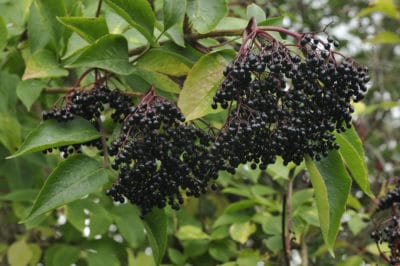Traits of the Elderberry Bush
Elderberries grow in many places and in the United States thrive in USDA hardiness zones 3 through 8 as a rule. Found most often in the wild the bush can, depending on the variety, grow from five feet to 12 feet tall, although some may be shorter or taller.
The elderberry bush features wooden bark on its trunk and branches and bears an umbrella-shaped flower cluster that seems almost flat when it is turned upright. These flower clusters, a white or cream color, will develop into bunches of berries eventually.
The fruit of the elderberry bush may be a waxy blue, similar to the blueberry, or a deep shiny purple. It also has a distinctive fruit cluster that is dissimilar to those of most other plants.
What Is Not an Elderberry Plant?
There are several plants that bear flowers or berries that can be confused with elderberry. Among these are:
- Carrots
- Queen Anne’s Lace
- Water Hemlock
- Parsley
- Pokeberry
There are others, too, but the most dangerous look alikes are the ones that are toxic. These are the water hemlock (flowers) and the pokeberry (fruit).
Water hemlock
The flower of this plant is quite similar in appearance to elderberry, but is toxic and should not be eaten! The easiest way to determine whether you are picking elderberry or water hemlock is to make sure it is on a bush, with wood and bark, rather than on a green plant growing out of the ground.
Additionally, the water hemlock flower tends to appear on a smaller umbell construct and the flowers are more open than the elderberry flower.
Pokeberries are another wild berry often confused with elderberries. The dark blue or purple pokeberries grow wild and are toxic.The most obvious differences between elderberry and pokeberry are that the flowers of the pokeberry grow in a narrow, cone-like bunch, while elderberries grow in larger cluster arrangements.
The stems tell the tale, too.The pokeberry and the water hemlock have stems that are usually red to purple; elderberry clusters have a green stem.
